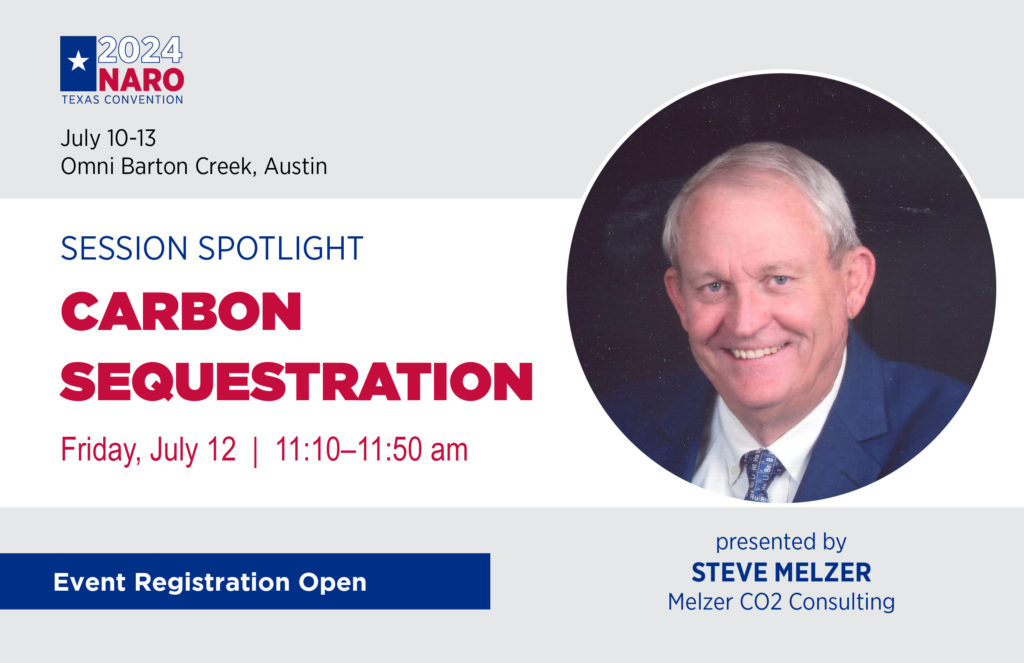The Two Very Different Types of Geologic CO2 Storage: Implications for Mineral Valuations
Steve Melzer Presentation
NARO Texas Outline
7-12-24: 11:00-11:50
The Two Very Different Types of Geologic CO2 Storage: Implications for Mineral Valuations
- Big Incentives for Emissions Capture, the Emission Sources, & the Two Capture Drivers: Taxes vs. Incentives
- Economic and Environmental Sustainability; Two Competing Imperatives?
- Who Regulates All of This?
- CCS & CCUS, Big Projects and Capital: Key Factors on Where to Put the Captured CO2?
- What are the Permanent Storage Analogs?
- What are the Storage Risks?
- What Roles do Storage and Mineral Rights Play?
- What is Incidental Storage?
- Big Projects, Huge Volumetrics & Dollars Involved
- Valuation Affects? The Mineral and Storage Rights ‘Skirmish’
- Summary and Who is Best to Permit Storage Sites?
Abstract
It is a widely accepted belief that capture and geologic storage of industrial emissions is a looming threat to mineral estates. Wrapped up in the concerns is the use (condemnation) of geological pore space to permanently store the surface captured carbon dioxide (CO2) thereby preempting any future removal of valued minerals. This is especially true in rich oil and gas mineral areas like most of the State of Texas.
But planning over the past 15 years carefully considered this concern and the formulation of the coming incentives for carbon emission capture took this worry into account. These incentives, now in place and called 45Q, have taken on a life of their own to encourage new facilities and retrofits to industrial plants to capture their emissions and thereby avoid what could be become obstacles to the sale of their products such as fertilizer, ethanol, electricity and many more.
What to do with the captured emissions can be grouped into two categories. One is injection into the earth’s reservoirs as a waste product (commonly referred to as sequestration or, alternatively, utilize the captured CO2 to make a second product. Work is underway to find new uses of CO2 such as in concrete, enhancing yields of biological products, etc. But all of these are dwarfed by the potential utilization of CO2 to enhance the production of oil like has been underway for 50 years. This process is called CO2 Enhanced Oil Recovery (EOR) and this process has produced over 3 billion barrels of oil while incidentally storing over a ton of CO2 for every barrel produced.
So how does this CO2 EOR process work? The sourced CO2 is injected in injection wells and a portion returns to the surface with the produced oil, is recaptured, recompressed and returned to make more oil in a closed loop system. Throughout the 50 years of EOR, the process has always been designed to minimize the volumes injected and stored since the CO2 was very expensive. Today, the CO2 is becoming available in large quantities and now the EOR projects are now being designed to better optimize the storage of CO2 along with the production of oil. These new projects are often even economic when the produced, ultimately combusted, oil released CO2 to the atmosphere is less than the incidentally stored CO2 used in producing it.
I will be reviewing these ideas and the approaches to mineral estate enhancements at the coming National Association of Royalty Owners (NARO Texas) meeting in Austin on Friday, July 12th. Some examples of the EOR (with incidental storage) projects coming to Texas will also be included. For more information and the full agenda see https://www.naro-us.org/event-5655135

